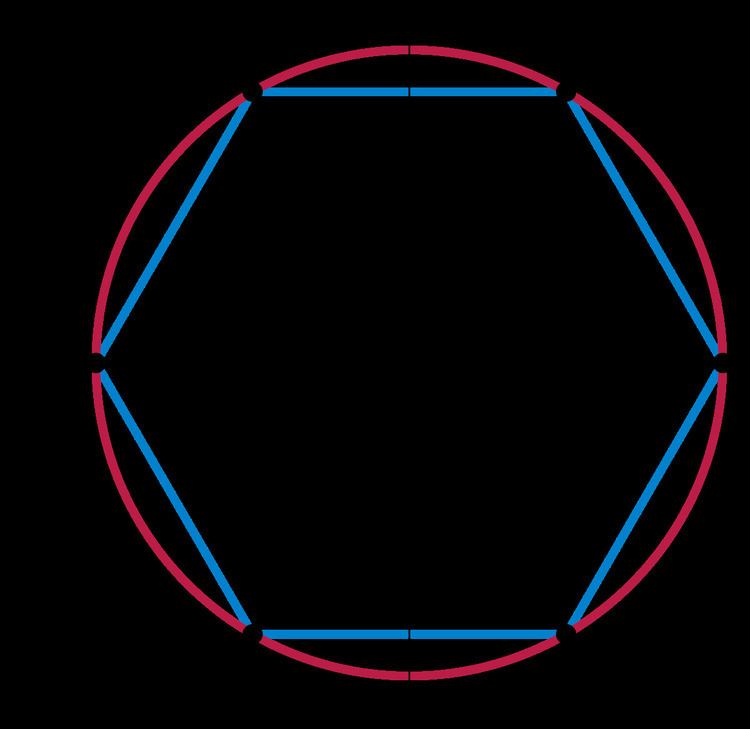 | ||
In mathematics, a Kleinian group is a discrete subgroup of PSL(2, C). The group PSL(2, C) of 2 by 2 complex matrices of determinant 1 modulo its center has several natural representations: as conformal transformations of the Riemann sphere, and as orientation-preserving isometries of 3-dimensional hyperbolic space H3, and as orientation preserving conformal maps of the open unit ball B3 in R3 to itself. Therefore, a Kleinian group can be regarded as a discrete subgroup acting on one of these spaces.
Contents
- Definitions
- Finiteness conditions
- Bianchi groups
- Elementary and reducible Kleinian groups
- Fuchsian groups
- Koebe groups
- Quasi Fuchsian groups
- Schottky groups
- Crystallographic groups
- Fundamental groups of hyperbolic 3 manifolds
- Degenerate Kleinian groups
- References
There are some variations of the definition of a Kleinian group: sometimes Kleinian groups are allowed to be subgroups of PSL(2, C).2 (PSL(2, C) extended by complex conjugations), in other words to have orientation reversing elements, and sometimes they are assumed to be finitely generated, and sometimes they are required to act properly discontinuously on a non-empty open subset of the Riemann sphere. A Kleinian group is said to be of type 1 if the limit set is the whole Riemann sphere, and of type 2 otherwise.
The theory of general Kleinian groups was founded by Felix Klein (1883) and Henri Poincaré (1883), who named them after Felix Klein. The special case of Schottky groups had been studied a few years earlier, in 1877, by Schottky.
Definitions
By considering the ball's boundary, a Kleinian group can also be defined as a subgroup Γ of PGL(2,C), the complex projective linear group, which acts by Möbius transformations on the Riemann sphere. Classically, a Kleinian group was required to act properly discontinuously on a non-empty open subset of the Riemann sphere, but modern usage allows any discrete subgroup.
When Γ is isomorphic to the fundamental group
Discreteness implies points in B3 have finite stabilizers, and discrete orbits under the group G. But the orbit Gp of a point p will typically accumulate on the boundary of the closed ball
The boundary of the closed ball is called the sphere at infinity, and is denoted
The unit ball B3 with its conformal structure is the Poincaré model of hyperbolic 3-space. When we think of it metrically, with metric
it is a model of 3-dimensional hyperbolic space H3. The set of conformal self-maps of B3 becomes the set of isometries (i.e. distance-preserving maps) of H3 under this identification. Such maps restrict to conformal self-maps of
The subgroups of these groups consisting of orientation-preserving transformations are all isomorphic to the projective matrix group: PSL(2,C) via the usual identification of the unit sphere with the complex projective line P1(C).
Finiteness conditions
Bianchi groups
A Bianchi group is a Kleinian group of the form PSL(2, Od), where
Elementary and reducible Kleinian groups
A Kleinian group is called elementary if its limit set is finite, in which case the limit set has 0, 1, or 2 points. Examples of elementary Kleinian groups include finite Kleinian groups (with empty limit set) and infinite cyclic Kleinian groups.
A Kleinian group is called reducible if all elements have a common fixed point on the Riemann sphere. Reducible Kleinian groups are elementary, but some elementary finite Kleinian groups are not reducible.
Fuchsian groups
Any Fuchsian group (a discrete subgroup of SL(2, R)) is a Kleinian group, and conversely any Kleinian group preserving the real line (in its action on the Riemann sphere) is a Fuchsian group. More generally, any Kleinian group preserving a circle or straight line in the Riemann sphere is conjugate to a Fuchsian group.
Koebe groups
Quasi-Fuchsian groups
A Kleinian group that preserves a Jordan curve is called a quasi-Fuchsian group. When the Jordan curve is a circle or a straight line these are just conjugate to Fuchsian groups under conformal transformations. Finitely generated quasi-Fuchsian groups are conjugate to Fuchsian groups under quasi-conformal transformations. The limit set is contained in the invariant Jordan curve, and it is equal to the Jordan curve the group is said to be of type one, and otherwise it is said to be of type 2.
Schottky groups
Let Ci be the boundary circles of a finite collection of disjoint closed disks. The group generated by inversion in each circle has limit set a Cantor set, and the quotient H3/G is a mirror orbifold with underlying space a ball. It is double covered by a handlebody; the corresponding index 2 subgroup is a Kleinian group called a Schottky group.
Crystallographic groups
Let T be a periodic tessellation of hyperbolic 3-space. The group of symmetries of the tessellation is a Kleinian group.
Fundamental groups of hyperbolic 3-manifolds
The fundamental group of any oriented hyperbolic 3-manifold is a Kleinian group. There are many examples of these, such as the complement of a figure 8 knot or the Seifert–Weber space. Conversely if a Kleinian group has no nontrivial torsion elements then it is the fundamental group of a hyperbolic 3-manifold.
Degenerate Kleinian groups
A Kleinian group is called degenerate if it is not elementary and its limit set is simply connected. Such groups can be constructed by taking a suitable limit of quasi-Fuchsian groups such that one of the two components of the regular points contracts down to the empty set; these groups are called singly degenerate. If both components of the regular set contract down to the empty set, then the limit set becomes a space-filling curve and the group is called doubly degenerate. The existence of degenerate Kleinian groups was first shown indirectly by Bers (1970), and the first explicit example was found by Jørgensen. Cannon & Thurston (2007) gave examples of doubly degenerate groups and space-filling curves associated to pseudo-Anosov maps.
